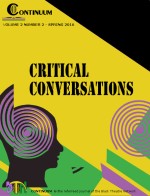The Brothers Size by Tarell Alvin McCraney
Directed by Anthony Stockard
Norfolk State University at The National Black Theatre Festival College Fringe
4 August 2015
The Brothers Size by Tarell McCraney was presented by Norfolk State University Theatre as part of the 2015 National Black Theatre Festival College Fringe, one of only two collegiate productions selected to participate. North Carolina Central University’s The Bluest Eye by Toni Morrison was the other. Size, the second installment of the The Brother/Sister Plays, is a premeditated remembering of Yoruba mythology and African storytelling purposed to involve the sensibilities of the audience. Bridging the gulf of the stage—an allegorical chthonic realm—actors are both divine and human as they chronicle fate and perform the story. This feature is one of the play’s charms.
Knowing attributes of the òrìṣà or divine energies the characters are drawn from and their related mythos adds an advantageous depth of understanding to a viewing of McCraney’s work and can make the experience a powerful one. The play, a ritual of brotherhood and becoming, is informed by the lore of a trio of òrìṣà, Ògún, Ochosi, and Elẹ́gbá. In the religious tradition of Ifá these three work together for an individual’s spiritual growth. Elẹ́gbá opens the road, Ochosi tells Ògún exactly what blockages or marks on the path to one’s destiny need targeting, and Ògún clears the obstacles.
In this narrative set in the “distant present,” Oshoosi (Christopher Lindsay) recently freed and integrating back into society is on the hunt for self-discovery but, gets distracted by his desire for a car and the warmth of a lady. The car is an extension of his desire for much more expansive notion of freedom and a woman’s touch would, perhaps, disprove or cure his growing sexual confliction. Ogun (Juspin Jones), Oshoosi’s brother, offers him the stability and shelter required by his parole officer. In the likeness of his divine namesake who protects orphans and covers the homeless, Ogun hires Oshoosi at his “Carshack” and gives him a place to lay his head. Ogun’s constrictive lifestyle isn’t what Oshoosi imagined. However, the arrival of the charming and deceptive Elegba (Derrick Moore) and the mounting eroticism between them, places Oshoosi on the crossroads of choice and change. In his mediatory role, Elẹ́gbá’s spiritual function in this regard is two-fold, to shed light on the warring selves of Oshoosi which need reconciling, his manhood and his sexual identity and to encourage Oshoosi to make careful decisions about his freedom.
When Elegba gifts him a car (with a pound of cocaine in the trunk) he challenges Oshoosi’s newly gained liberty. The planted drugs will land them back in prison . . . together, where it may be less difficult for Oshoosi to fight Elegba’s sexual advances. At the play’s conclusion, Oshoosi is on the run from the law, Elegba, and perhaps himself. With only his brother’s confidence in his innocence, truck, savings and love, Oshoosi moves out into the world he has yet to explore beyond the confinement of San Pere in search of himself. In the morning dawn, the final tableau of Ogun isolated in his garage, with only memories of Oshoosi reminds us that the ‘road [of self-discovery] is rough’ and sometimes lonely. However, “there is a friend that sticketh closer than a brother,” even if only in spirit.
In his first year as NSU Theatre Director, Stockard made milestones in the 2014-2015 production season, a year which boasted staples from the canon of Black Theatre—A Raisin in the Sun, for colored girls, Dreamgirls, and a reprisal from his own directing repertoire—the 2012 Cloverdale Playhouse production of Lady Day at Emerson’s Bar & Grill.
Both Alabama State University transfers to NSU, the physically engaging Lindsay and cunning Moore have been under Stockards’ direction for some time and it shows. Missing from overall notable performances was the gradually rising sexual tension between Elegba and Oshoosi, which should begin with Elegba’s arrival early in the play. The authoritative and invested Jones had a limiting predilection for irritation and anger when McCraney’s text calls for more emotional complexity. In Act 2.5 Oshoosi states to Ogun,
You act like you don’t care . . .
You act like you so tough but I would catch it . . .
I catch you looking at me sometimes like you wanna beat
my ass you so mad.
Then I see this smile crack.
I see it and I see you . . . (McCraney 226-227)
Beyond the Temptations duet between the Size brothers near the play’s end (an effective public engagement) and Oshoosi’s departure, Jones’ Ogun was “hard all the time.” It seemed that the legends of Ògún preceded Brother Size Number One. His mythic portrayals of rash brutality and stoicism as context present a challenge for any actor to create a more nuanced emotional symphony in performance. Yet, such execution is critical to The Brothers Size and its theme of fellowship among men.
As noted earlier, through the character’s narration of stage directions, the play becomes a joint performance inviting the audience to co-create the world of the text through their imagination of the story. As such, Size does not demand much in the way of props and/or set but does beg for a breaking of the fourth wall. Intimacy between the performer and spectator—an aesthetic of the African folktale tradition—was lost in this production because of its presentation in the Winston-Salem State University Dillard Auditorium. The location gave the show a distant and presentational feel. The performance would have been better served in an arena or thrust arrangement or at a minimum, the whole world of the play moved downstage of the proscenium line. This of course would have presented a lighting problem, an existing glitch noticeable by the trussing within seats near the back of the house to account for the fact that most of the lighting instruments for the auditorium were behind the proscenium line.
As scenic designer, Stockard builds upon the metaphoric design of his previous work from the 2014 Theatrical Outfit production of Size (also under his direction). The constructivist framing was inset within a proscenium frame—a threshold casing for Ogun’s garage—entrenched with swamp moss and the symbology of the òrìṣà along the top border. The design subtly evoked both the skyline of a project community in the Louisiana bayou and the confinement of a prison. Ramona Ward’s striking and symbolic costumes and òrìṣà crowns from the 2013 Cloverdale Playhouse production of Size were reprised for this showing and reinforced the beauty of Yoruba art. McCraney’s musical dialogue was accompanied by Stockard’s adroit sound design and Desmond Holland’s distinctive choreography and embodied.
The addition of the Egúngún during the opening invocation and dream sequences—stunning aesthetically—was a unique departure from McCraney’s text and raises additional questions. While it is true that the deities, the ancestors, and the unborn occupy the same space in African thought, it was unclear why such a ritual bridge to the ancestral presence was necessary. Or was the Egúngún a metaphor for the past—perhaps Oshoosi’s unsettled and intimate past with Elegba? How this signification serves this particular production remains unclear.
What is certain is that it is no small victory to be included in the NBTF College Fringe and is quite a plume in the NSU Spartan helmet. Despite the four issues raised, the production was commendable, a testament to the potential of its students and definitively, the positive influence of Stockard’s direction of the theatre program.
Artisia Green
College of William and Mary
Works Cited
McCraney, Tarell, Alvin. 2010. “The Brothers Size.” In The Brother/Sister Plays. New York, NY: Theatre Communications Group.



